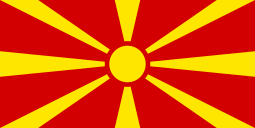Gazi Hajdar Kadi Mosque
| Gazi Hajdar Kadi Mosque | |
|---|---|
.jpg) | |
| Basic information | |
| Location | Bitola, Macedonia |
| Geographic coordinates | 41°2′5.97″N 21°20′18.51″E / 41.0349917°N 21.3384750°ECoordinates: 41°2′5.97″N 21°20′18.51″E / 41.0349917°N 21.3384750°E |
| Affiliation | Islam |
| Country | Republic of Macedonia |
| Architectural description | |
| Architect(s) | Mimar Sinan |
| Architectural type | Mosque |
| Architectural style | Classical period Ottoman Architecture |
| Completed | 1561 |
| Specifications | |
| Length | 11m |
| Width | 11m |
| Minaret(s) | 1 |
| Materials | Marble & Stone |
The Gazi Hajdar Kadi Mosque, (Macedonian: Ајдар Кади Џамија; Turkish: Gazi Haydar Kadi Cami) is a mosque, situated in Bitola, Republic of Macedonia. In the past the religious building has been transformed into a warehouse by the local Macedonian authorities.[1] A thorough reconstruction was undergoing for several years, and finally it was fully put into service and opened to public in November 2016.
History
The mosque was commissioned by Haydar Bey, then beylerbey of Rumelia Eyalet, the largest Ottoman administrative territory, with Manastir as a regional centre. According to the inscription in Arabic on the stone plaque above the door, the mosque was built in 969 he (1561/62 AD). The mosque is a domed building with massive walls of about 1.4 meters thick. The builders came from a small village in the region of Manastir but the project was most probably prepared by an unknown Islamic architect, influenced by the work of famous architects of that time, such as Kodja Sinan. In the description of Evlia Celebi's travels through the Balkans in the 17th century, this mosque was considered as one of the most beautifully decorated. Study of the remains show that the Haydar-Kadi Mosque was the only mosque in Bitola with two minarets. Marble decorations adorn the mihrab and the triangle-shaped tromps. A stone bas-relief can be seen on the portal, capitals and on the mimbar. Colourful geometrical designs can be found around the windows, on the arches, as well as on the tromps. The wood-carved door is executed in bas-relief. The most distinctive motif is the stylized Arabic letter "elif'. This type of woodcarved doors can be seen in Istanbul mosques. The mosque was repaired in 1890. We also know that all the mosques of the town were restored before the visit of the Mehmed V in 1910, a fact confirmed by certain elements of the interior decoration painted at that time.
References
- ↑ The settlements with muslim population in Macedonia. Logos-A. 2005. pp. 206–. ISBN 978-9989-58-155-7.

